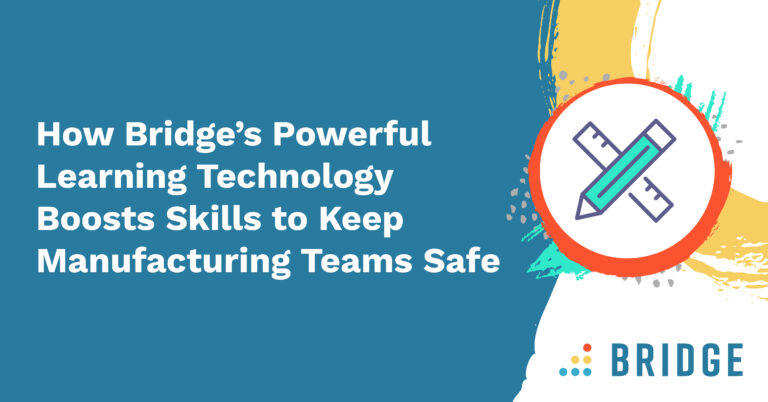In the third post of our “How to Develop Employees in the Changing Face of Work” series, we discussed the four working styles you’ll encounter in the workplace and how to better manage them.
Now it’s time to dig in to how to best fill in the epic skills gap through employee development. The good news is, your modern employees crave—and even demand—to learn on the job.
A culture of learning truly is the secret sauce for not only getting the best out of your team but getting them to stick around, too. An astounding 94 percent of employees say they’d stay longer at a company that offered ongoing development.
So, what kind of training do these knowledge-hungry employees need in their learning management systems? According to LinkedIn’s 2018 Workplace Learning Report, the most important skills direct reports should learn from L&D programs are:
- Communication: 66%
- Leadership: 56%
- Collaboration: 50%
- Role-specific skills: 49%
- Time management: 34%
- Program or platform usage: 24%
But how you train can be just as vital to your employees as the very skills you’re trying to impart on them. Every member of your team is a special snowflake, so providing meaningful learning experiences is more important than ever. One way to do that is to tailor your content to the learning styles of your team.
Depending on who you ask, there are many different learning styles (more than we can cover here). Let’s focus on the broad strokes you’ll find in the workplace:
Visual learners – a whopping 65 percent of adults fall into the visual learner category, meaning an image is the best way to present information to this group. Unfortunately, the reams of information you’ll need to impart can’t magically be condensed into 10 images (1,000 words divided by 1 photo = not gonna fly). But, images and videos should be an important part of the training to engage the majority of your learners.
Be sure your e-learning courses include a feast for the eyes—and ultimately the brains—of your modern workforce, including:
- Infographics, charts, diagrams, SFW memes
- Video (even with the sound off) and the use of supers, or text on the screen
- Elearning courses that incorporate tons of images
Aural, or auditory learners – these folks grasp key concepts when they are shared aloud. Sound, rhythm and music are their mediums of choice. They make up around 30 percent of the population and often enjoy a good debate.
To engage aural learners, make sure your training materials include a mix of:
- Video with voice-overs
- Model responses they can mimic
- Podcasts or pre-recorded audio presentations
- Blended learning – a combination of online and in-person development
Verbal learners – speech, reading and writing are the foundations of successful information download for verbal learners. They typically enjoy learning new words and using language creatively. Verbal learners usually have a strong recall of materials or books they’ve read and are usually exceptional test takers.
Keep reading learners tuned into your content by including:
- Role-playing activities
- Practice making sales calls and pitches (recording themselves and watching others)
- Video with voice-overs
- Video transcripts
- Ebooks and long-form content
- Presentations
Kinesthetic learners – a rare breed, kinesthetic learners make up only 5 percent of the population. These learners use their senses to help grasp key concepts and prefer to learn by doing (which can make scalable training a challenge at times).
Most of your training content will appeal to visual, reading and auditory learners. To keep kinesthetic learners engaged, assign activities and exercises that stimulate more of the senses, like:
- Active skills assessments and feedback
- Role-playing scenarios
- Group activities
To make things even more interesting, we learn different types of material in different ways—don’t pigeonhole your employees into one category or another.
Don’t feel like you have to reinvent the wheel with your training to provide formats that accommodate all learning styles for every subject or skill. In some cases, simply adding supplemental material to your standard online courses and videos can help explain key concepts in ways that will do the trick.
So Many Styles, One Overarching Solution: Social Learning
Yes, there are social learners who learn best through others, but in today’s overly social world, all of your learners can benefit from social learning.
Social learning is simply the sharing of knowledge in a social or collaborative setting, whether it comes in the form of imitation, observation, engagement in group chats or direct instruction from peers.
Here’s how to foster more social learning in your development programs:
- Interactive video with just-in-time comments – video may be a visual learner’s best friend, but video with interactive comments takes learning to a whole new level. Employees who take the course can post a comment or question for all to see at the exact moment in the video, then subsequent video viewers can respond to keep the conversation going, or simply learn from their peers’ exchange.
- Community or discussion groups – learners of all types (except maybe kinesthetic) can benefit from e-learning with video and images. But to really kick it up a notch, enable discussion groups within the courses to get—and keep—your team engaged.
- Peer-to-peer coaching sessions – peer feedback carries some serious clout with your employees, as 76 percent are motivated by positive feedback from their peers. Platforms like Bridge Practice enable video assessment and peer-to-peer coaching while actively perfecting key job skills.
Of course, not all learning can be social. But adding a social element to any training activity is a great way to keep all your learners into it, no matter their learning style.
Stay tuned for the final post in our “How to Develop Employees in the Changing Face of Work” series, where we’ll drop some career development tools on you that you won’t wanna miss.



